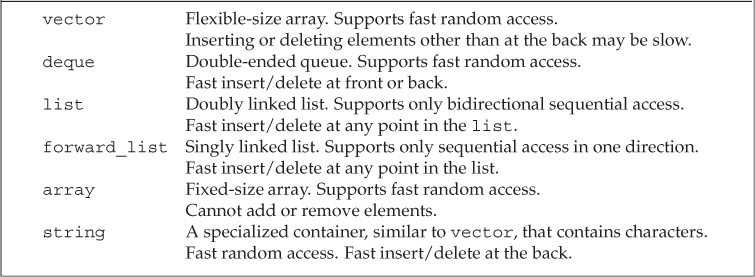 9.1. Overview of the Sequential Containers
by Barbara E. Moo, Josée Lajoie, Stanley B. Lippman
C++ Primer, Fifth Edition
9.1. Overview of the Sequential Containers
by Barbara E. Moo, Josée Lajoie, Stanley B. Lippman
C++ Primer, Fifth Edition
- Title Page
- Copyright Page
- Dedication Page
- Contents
- New Features in C++11
- Preface
- Chapter 1. Getting Started
- Part I. The Basics
- Contents
- Chapter 2. Variables and Basic Types
- Chapter 3. Strings, Vectors, and Arrays
- Chapter 4. Expressions
- Contents
- 4.1. Fundamentals
- 4.2. Arithmetic Operators
- 4.3. Logical and Relational Operators
- 4.4. Assignment Operators
- 4.5. Increment and Decrement Operators
- 4.6. The Member Access Operators
- 4.7. The Conditional Operator
- 4.8. The Bitwise Operators
- 4.9. The sizeof Operator
- 4.10. Comma Operator
- 4.11. Type Conversions
- 4.12. Operator Precedence Table
- Chapter Summary
- Defined Terms
- Chapter 5. Statements
- Chapter 6. Functions
- Chapter 7. Classes
- Part II. The C++ Library
- Contents
- Chapter 8. The IO Library
- Chapter 9. Sequential Containers
- Chapter 10. Generic Algorithms
- Chapter 11. Associative Containers
- Chapter 12. Dynamic Memory
- Part III. Tools for Class Authors
- Contents
- Chapter 13. Copy Control
- Chapter 14. Overloaded Operations and Conversions
- Contents
- 14.1. Basic Concepts
- 14.2. Input and Output Operators
- 14.3. Arithmetic and Relational Operators
- 14.4. Assignment Operators
- 14.5. Subscript Operator
- 14.6. Increment and Decrement Operators
- 14.7. Member Access Operators
- 14.8. Function-Call Operator
- 14.9. Overloading, Conversions, and Operators
- Chapter Summary
- Defined Terms
- Chapter 15. Object-Oriented Programming
- Contents
- 15.1. OOP: An Overview
- 15.2. Defining Base and Derived Classes
- 15.3. Virtual Functions
- 15.4. Abstract Base Classes
- 15.5. Access Control and Inheritance
- 15.6. Class Scope under Inheritance
- 15.7. Constructors and Copy Control
- 15.8. Containers and Inheritance
- 15.9. Text Queries Revisited
- Chapter Summary
- Defined Terms
- Chapter 16. Templates and Generic Programming
- Part IV. Advanced Topics
- Contents
- Chapter 17. Specialized Library Facilities
- Chapter 18. Tools for Large Programs
- Chapter 19. Specialized Tools and Techniques
- Appendix A. The Library
- Contents
- A.1. Library Names and Headers
- A.2. A Brief Tour of the Algorithms
- A.2.1. Algorithms to Find an Object
- A.2.2. Other Read-Only Algorithms
- A.2.3. Binary Search Algorithms
- A.2.4. Algorithms That Write Container Elements
- A.2.5. Partitioning and Sorting Algorithms
- A.2.6. General Reordering Operations
- A.2.7. Permutation Algorithms
- A.2.8. Set Algorithms for Sorted Sequences
- A.2.9. Minimum and Maximum Values
- A.2.10. Numeric Algorithms
- A.3. Random Numbers
- Index
- Add Pages
9.1. Overview of the Sequential Containers
The sequential containers, which are listed in Table 9.1, all provide fast sequential access to their elements. However, these containers offer different performance trade-offs relative to
• The costs to add or delete elements to the container
• The costs to perform nonsequential access to elements of the container
Table 9.1. Sequential Container Types

With the exception of array, which is a fixed-size container, the containers provide efficient, flexible memory management. We can add and remove elements, growing and shrinking the size of the container. The strategies that the containers use for storing their elements have inherent, and sometimes significant, impact on the efficiency of these operations. In some cases, these strategies also affect whether a particular container supplies a particular operation.
For example, string and vector hold their elements in contiguous memory. Because elements are contiguous, it is fast to compute the address of an element from its index. However, adding or removing elements in the middle of one of these containers takes time: All the elements after the one inserted or removed have to be moved to maintain contiguity. Moreover, adding an element can sometimes require that additional storage be allocated. In that case, every element must be moved into the new storage.
The list and forward_list containers are designed to make it fast to add or remove an element anywhere in the container. In exchange, these types do not support random access to elements: We can access an element only by iterating through the container. Moreover, the memory overhead for these containers is often substantial, when compared to vector, deque, and array.
A deque is a more complicated data structure. Like string and vector, deque supports fast random access. As with string and vector, adding or removing elements in the middle of a deque is a (potentially) expensive operation. However, adding or removing elements at either end of the deque is a fast operation, comparable to adding an element to a list or forward_list.
The forward_list and array types were added by the new standard. An array is a safer, easier-to-use alternative to built-in arrays. Like built-in arrays, library arrays have fixed size. As a result, array does not support operations to add and remove elements or to resize the container. A forward_list is intended to be comparable to the best handwritten, singly linked list. Consequently, forward_list does not have the size operation because storing or computing its size would entail overhead compared to a handwritten list. For the other containers, size is guaranteed to be a fast, constant-time operation.
For reasons we’ll explain in § 13.6 (p. 531), the new library containers are dramatically faster than in previous releases. The library containers almost certainly perform as well as (and usually better than) even the most carefully crafted alternatives. Modern C++ programs should use the library containers rather than more primitive structures like arrays.
-
No Comment